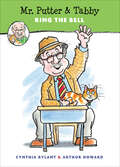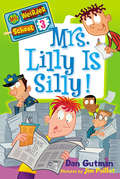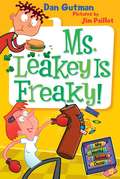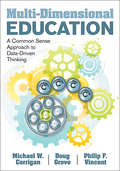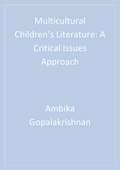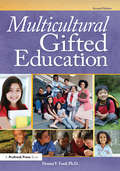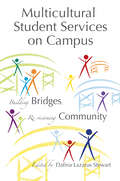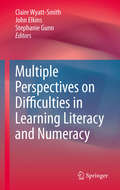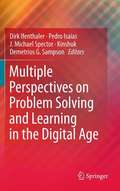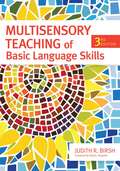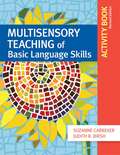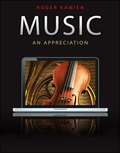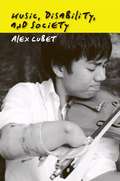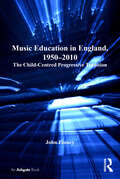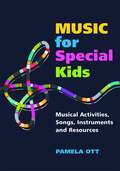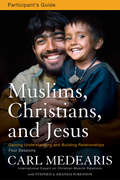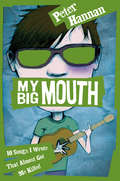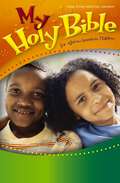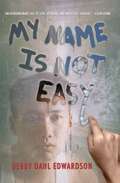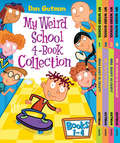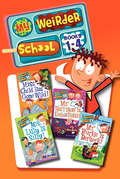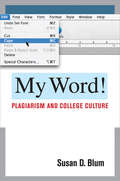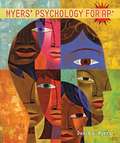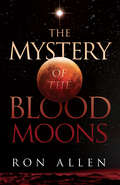- Table View
- List View
Mr. Putter & Tabby Ring the Bell (Mr. Putter & Tabby #22)
by Cynthia Rylant Arthur HowardIt&’s back to school time, and some very special guests are coming to class! &“These four neighbors are great company.&”—Kirkus Reviews Dong! Dong! Dong! The school bell is ringing. The crispy fall wind is blowing. Mr. Putter wishes he could go back to school—even for just one day. Then he has an idea: How about a visit during show-and-tell with Mrs. Teaberry, Tabby the cat, and Zeke the dog? The teacher agrees, but there&’s one problem. She and the students expect to see some pet tricks. Will Tabby and Zeke be able to deliver? &“An amusing fall-flavored offering from the Mr. Putter and Tabby series that&’s good for reading aloud or reading alone.&”—Booklist
Mrs. Lilly Is Silly! (My Weirder School #3)
by Dan Gutman Jim PaillotMy Weirder School weirder than ever! <P><P> It's Career Day at Ella Mentry School! Mrs. Lilly is a reporter for the local paper. She's going to come help the kids make their own newspaper, all about the school. What will happen when A.J. and the gang become investigative reporters? Who's going to get fired? Who's going to end up in jail?
Ms. Leakey Is Freaky! (My Weird School Daze #12)
by Jim Paillot Dan GutmanThe weirdness never stops! <P><P> Oh no! Kids are getting too unhealthy, so Ella Mentry School has hired a health teacher to help the kids eat right and exercise. Ms. Leakey is a real health nut. She makes a punching bag filled with junk food! She designs a robot that smokes and drinks! She opens up a fast food restaurant that sells broccoli burgers! She puts sunscreen on her car!
Multi-Dimensional Education: A Common Sense Approach to Data-Driven Thinking
by Michael W. Corrigan Dr Douglas Grove Philip F. VincentA comprehensive guide to data-driven school improvement Look beyond student test scores with a practical and multidimensional data gathering approach. The authors detail the steps for identifying, collecting, analyzing, and using data as a basis for making instructional and schoolwide decisions. This book’s seven-dimensional model outlines how to apply data to these key processes: Assessing student achievement, Modifying instruction based on data findings, Improving school performance. The result is a holistic and accurate instrument for making the changes needed to improve student learning. This practical guide will assist you in instituting common standards using the data systems outlined. Includes assessment tools, graphic organizers, and rubrics.
Multicultural Children’s Literature: A Critical Issues Approach
by Ambika G. GopalakrishnanThis book is designed to prepare K-12 preservice and inservice teachers to address the social, cultural, and critical issues of our times through the use of multicultural children's books. It will be used as a core textbook in courses on multicultural children's literature and as a supplement in courses on children's literature and social studies teaching methods. It can also be used as a supplement in courses on literacy, reading, language arts, and multicultural education.
Multicultural Gifted Education
by Donna Y. FordEach year, the United States witnesses significant changes in the demographics of its citizens. Accordingly, schools—and the students we teach—are also changing. With such changes come the need, responsibility, and obligation for educators to provide students with an education that is both rigorous and culturally responsive. This book bridges the gap that exists between educating advanced learners and educating culturally different learners. Multicultural Gifted Education, 2nd ed. addresses various topics, including racially and culturally diverse students and families, historical and legal perspectives on educating gifted and minority students, culturally responsive curriculum and assessment, and counseling students from a multicultural perspective.
Multicultural Student Services on Campus: Building Bridges, Re-visioning Community (An ACPA Co-Publication)
by Dafina Lazarus StewartCo-published with For new professionals in multicultural student services (MSS), this book constitutes a thorough introduction to the structure, organization, and scope of the services and educational mission of these units. For senior practitioners it offers insights for re-evaluating their strategies, and inspiration to explore new possibilities.The book discusses the history and philosophy of MSS units; describes their operation; asserts the need for integration and coherence across the multiple facets of their work and how their role is influenced by the character and type of their institutions; and considers the challenges and opportunities ahead. The theme Building Bridges, Re-Visioning Community reflects the dual role of MSS. They “build bridges” between underrepresented student populations and the broader institutional environment, between different groups of student populations, and across differences in cultural values and traditions. At a time of increasing diversity on campus, their role is also to champion the “re-visioning” or redefinition of what constitutes community in higher education – in other words to reach beyond serving their traditional constituencies to educate for multicultural competence, and advocate for social justice across the campus commons.This book is organized in four sections moving the reader from the past to the present to the future, and from a service mission to an educational one. Part One reviews the purposes for which MSS were created, and the evolution of their vision, concluding an overview of how units perceive their needs and challenges today.Part Two addresses a range of issues – such as race/ethnicity, sexual orientation / gender identity, and religion/faith diversity – commonly addressed by MSS, and, in recognizing the tensions inherent in serving such disparate constituencies, advances ideas for bringing greater integration and coherence to their work.Part Three considers how institutional context influences the structure and organization of MSS, and addresses such questions as: Who are they serving? What kind of support services and educational programming can they provide? How broadly or narrowly should they define their role, and can they extend their influence through alliances with other campus units?The book concludes by looking at how MSS can re-vision community to ensure their continued relevance to the college or university community.An ACPA Publication
Multiple Perspectives on Difficulties in Learning Literacy and Numeracy
by Claire Wyatt-Smith Stephanie Gunn John ElkinsThere are many approaches to researching the difficulties in learning that students experience in the key areas of literacy and numeracy. This book seeks to advance understanding of these difficulties and the interventions that have been used to improve outcomes. The book addresses the sometimes complementary and sometimes contradictory results, and generates new approaches to understanding and serving students with difficulties in literacy and numeracy. The book represents a departure from conventional wisdom as most scholars and graduate students draw upon ideas from only one of the three domains focal in the book and usually from one single or dominant theoretical frame. Typically, readers will affiliate with reading education, mathematics education, or learning disabilities and belong to one of the corresponding professional associations such as IRA, NCTM, or CLD. This book's scope will open a scholarly forum for engaging readers with a familiarity with one of these domains while providing insight into the others on offer in the book.
Multiple Perspectives on Problem Solving and Learning in the Digital Age
by Dirk Ifenthaler J. Michael Spector Kinshuk Pedro Isaias Demetrios G. SampsonThis edited volume with selected expanded papers from CELDA (Cognition and Exploratory Learning in the Digital Age) 2009 (http://www.celda-conf.org/) addresses the main issues concerned with problem solving, evolving learning processes, innovative pedagogies, and technology-based educational applications in the digital age. There have been advances in both cognitive psychology and computing that have affected the educational arena. The convergence of these two disciplines is increasing at a fast pace and affecting academia and professional practice in many ways. Paradigms such as just-in-time learning, constructivism, student-centered learning and collaborative approaches have emerged and are being supported by technological advancements such as simulations, virtual reality and multi-agents systems. These developments have created both opportunities and areas of serious concerns. This volume aims to cover both technological as well as pedagogical issues related to these developments.
Multisensory Teaching of Basic Language Skills (3rd Edition)
by Judith R. BirschAs new research shows how effective systematic and explicit teaching of language-based skills is for students with learning disabilities—along with the added benefits of multisensory techniques—discover the latest on this popular teaching approach with the third edition of this bestselling textbook. Adopted by colleges and universities across the country, this definitive core text is now fully revised and expanded with cutting-edge research and more on hot topics such as executive function, fluency, and adolescent literacy. The most comprehensive text available on multisensory teaching, this book shows preservice educators how to use specific multisensory approaches to dramatically improve struggling students' language skills and academic outcomes in elementary through high school.
Multisensory Teaching Of Basic Language Skills Activity Book
by Suzanne Carreker Judith R. BirshWith the new edition of this activity book--the companion to Judith Birsh's bestselling text, Multisensory Teaching of Basic Language Skills--students and practitioners will get the practice they need to use multisensory teaching effectively with students who have dyslexia and other learning disabilities. Ideal for both pre-service teacher education courses and in-service professional development, the activity book aligns with the third edition of the Multisensory Teaching textbook, so readers can easily use them in tandem.
Music: An Appreciation (10th edition)
by Roger KamienWhat does it take to make a great performance? It takes great music, a great performer and a great instrument. Music: An appreciation examines some of the greatest music ever created. Roger Kamien's excellence as an interpreter of that music has made his program number one in the market used by over half a million students since its conception. Now, connect Kamien provides the world-class instrument that allows Music: An Appreciation to bring great music to his audience in an extraordinary new way. Music: An Appreciation is the right music, the right interpreter, and the right instrument.
Music, Disability, and Society
by Alex LubetMusical talent in Western culture is regarded as an extraordinary combination of technical proficiency and interpretative sensitivity. In Music, Disability, and Society, Alex Lubet challenges the rigid view of technical skill and writes about music in relation to disability studies. He addresses the ways in which people with disabilities are denied the opportunity to participate in music. Elaborating on the theory of "social confluence," Lubet provides a variety of encounters between disability and music to observe radical transformations of identity. Considering hand-injured and one-handed pianists; the impairments of jazz luminaries Django Reinhardt, Horace Parlan, and "Little" Jimmy Scott; and the "Blind Orchestra" of Cairo, he shows how the cultural world of classical music contrasts sharply with that of jazz and how musicality itself is regarded a disability in some religious contexts. Music, Disability, and Society also explains how language difference can become a disability for Asian students in American schools of music, limiting their education and careers. Lubet offers pungent criticism of the biases in music education and the music profession, going so far as to say that culture disables some performers by adhering to rigid notions of what a musician must look like, how music must be played, who may play it, and what (if any) is the legitimate place of music in society. In Music, Disability, and Society, he convincingly argues that where music is concerned, disability is a matter of culture, not physical impairment.
Music Education in England, 1950-2010: The Child-Centred Progressive Tradition
by John FinneyJohn Finney examines the child-centred progressive tradition to create a fresh way of evaluating ideas and practices that have evolved since 1950, that have shaped the lives of music teachers and their pupils, and that have now become disfigured, residual and altogether lost in the light of social, cultural and political change. The book is a critique of the present situation with an intention to expose the dangers in our current pursuit of future gains that are thought to serve the making and sustaining of the social order. The project draws in major debates of the period, along with their protagonists, counter-pointed by the voices of teachers and pupils. At the same time, the structuring voices of policy and governance become ever louder as we reach the present time. Finney presents a compelling, analytical account through a series of six episodes, each seeking to capture the spirit and fervour characteristic of a particular phase within the period studied. In the concluding chapter the narrative developed is reviewed. From this the idea of music education as an ethical pursuit is proposed. Finney argues that classroom relationships can be thought of as playfully dialogic, where teacher and pupil remain curious, and where there is serious attention to what is to be taught and why. This will always need to be negotiated, with the expressed and inferred needs of children working together to find a critical approach to what is being learnt. Finney's book provides fresh inspiration for practitioners and new challenges for researchers, and as such is a landmark in the field of arts and music education.
Muslims, Christians, and Jesus Participant's Guide: Gaining Understanding and Building Relationships
by Carl Medearis stephen SorensonAccording to author Carl Medearis, how Americans responds to Islam and how Christians think of Muslims could be the most significant issues of our time. In this four-session video study with corresponding participant’s guide, Medearis helps American Christians understand the basics of Islam, the difference between “moderate” Muslims and radical terrorists, the Muslim view of Jesus, and how we as Christians should interact with our Muslim neighbors, friends, and coworkers. From the Ground Zero mosque to whether we believe in the same God, Medearis also addresses key questions and responses to the current Muslim/Christian tensions facing our society. Designed for use with the video.
My Big Mouth: 10 Songs I Wrote That Almost Got Me Killed
by Peter HannanA hilarious illustrated novel from the creator of CatDog! Davis Delaware is not from Delaware. But try telling that to everyone at his new school. When you move in the middle of ninth grade, people are going to think whatever they want about you. If they pay attention at all. Blending in is fine with Davis. He just wants to doodle in his notebook. Make a few friends. Not rock the boat. Easier said than done. Because when he starts a band called The Amazing Dweebs with beautiful Molly and nerdy Edwin, Davis rocks the boat big-time. And all that rocking gets the attention of school bully Gerald ""the Butcher"" Boggs. Now Davis is suddenly king of the school -- and the Butcher's next target. This can't end well.
My Holy Bible for African-American Children, NIV
by Cheryl HudsonA Bible just for you! Finally, a Bible created just for African-American children. Explore God’s Word with this Bible created just for you and discover how much God knows you and loves you. • 32 full-color pages featuring art from leading African-American illustrators • Book introductions help explain what each book of the Bible is about • Large print type for easy reading • Dictionary-concordance, and color maps for better understanding • Presentation page for gift giving • Complete text of the New International Version, the most-read, most-trusted Bible translation
My Name Is Not Easy
by Debby Dahl Edwardson<P>Luke knows his Iñupiaq name is full of sounds white people can't say. He knows he'll have to leave it behind when he and his brothers are sent to boarding school hundreds of miles from their Arctic village. <P>At Sacred Heart School things are different. Instead of family, there are students -- Eskimo,Indian, White -- who line up on different sides of the cafeteria like there's some kind of war going on. <P>And instead of comforting words like tutu and maktak, there's English. Speaking Iñupiaq -- or any native language -- is forbidden. <P>And Father Mullen, whose fury is like a force of nature, is ready to slap down those who disobey. Luke struggles to survive at Sacred Heart. <P>But he's not the only one. <P>There's smart-aleck Amiq, a daring leader -- if he doesn't self destruct; Chickie, blond and freckled, a different kind of outsider; and small quiet Junior, noticing everything and writing it all down. <P> Each has their own story to tell. But once their separate stories come together, things at Sacred Heart School -- and in the wider world -- will never be the same. <P>Mainly based on true events, this story tells of Alaska of the mid-60's.
My Weird School 4-Book Collection with Bonus Material
by Jim Paillot Dan GutmanDon't miss out on an exciting new My Weird School ebook collection, complete with the first four books in Dan Gutman's seriously hilarious and seriously zany series. The collection includes My Weird School #1: Miss Daisy Is Crazy!, My Weird School #2: Mr. Klutz Is Nuts!, My Weird School #3: Mrs. Roopy Is Loopy!, My Weird School #4: Ms. Hannah Is Bananas!, and a bunch of seriously strange activities. The activities include a checklist, a maze, and a word scramble. Meet a teacher who eats bonbons, a principal who kisses pigs, a librarian who thinks she's George Washington, and an art teacher who dresses up in pot holders! They're all inside this collection! They must be getting pretty crowded in there!
My Weirder School Collection: Books 1-4
by Jim Paillot Dan GutmanMeet Miss Child, a zookeeper who eats lunch with baboons; Mr. Harrison, a tech guy who is on the fritz; Mrs. Lilly, a reporter who digs up dirt; and Mr. Burke, a groundskeeper who races lawnmowers! Will Ella Mentry School ever be the same? Read this four-book collection to find out!
My Word!: Plagiarism and College Culture
by Susan D. Blum"Classroom Cheats Turn to Computers." "Student Essays on Internet Offer Challenge to Teachers." "Faking the Grade." Headlines such as these have been blaring the alarming news of an epidemic of plagiarism and cheating in American colleges: more than 75 percent of students admit to having cheated; 68 percent admit to cutting and pasting material from the Internet without citation. Professors are reminded almost daily that many of today's college students operate under an entirely new set of assumptions about originality and ethics. Practices that even a decade ago would have been regarded almost universally as academically dishonest are now commonplace. Is this development an indication of dramatic shifts in education and the larger culture? In a book that dismisses hand-wringing in favor of a rich account of how students actually think and act, Susan D. Blum discovers two cultures that exist, often uneasily, side by side in the classroom.Relying extensively on interviews conducted by students with students, My Word! presents the voices of today's young adults as they muse about their daily activities, their challenges, and the meanings of their college lives. Outcomes-based secondary education, the steeply rising cost of college tuition, and an economic climate in which higher education is valued for its effect on future earnings above all else: These factors each have a role to play in explaining why students might pursue good grades by any means necessary. These incentives have arisen in the same era as easily accessible ways to cheat electronically and with almost intolerable pressures that result in many students being diagnosed as clinically depressed during their transition from childhood to adulthood.However, Blum suggests, the real problem of academic dishonesty arises primarily from a lack of communication between two distinct cultures within the university setting. On one hand, professors and administrators regard plagiarism as a serious academic crime, an ethical transgression, even a sin against an ethos of individualism and originality. Students, on the other hand, revel in sharing, in multiplicity, in accomplishment at any cost. Although this book is unlikely to reassure readers who hope that increasing rates of plagiarism can be reversed with strongly worded warnings on the first day of class, My Word! opens a dialogue between professors and their students that may lead to true mutual comprehension and serve as the basis for an alignment between student practices and their professors' expectations.
Myers' Psychology for AP*
by David G. MyersAlready The Bestselling AP* Psychology Author, Myers Writes His First Exclusive AP* Psych Text. David G. Myers is best known for his top-selling college psychology texts, used successfully across North America in thousands of AP* courses. As effective as Myers' college texts have been for the AP* course, we believe his new text will be even better, because Myers' Psychology for AP* has been written especially for the AP* course!
Myers' Psychology for AP
by David G. MyersA comprehensive psychology textbook for high school students interested in AP level learning.
The Mystery of the Blood Moons
by Ron Allen&“The story of the stars is the story of the Creator Himself, told in His own words and pictures – and painted with fire across the expanse of the universe.&” The Scriptures tell us that the heavens declare God&’s glory. Yet, Christians avoid concentrating too intently on messages that might be written in the stars, for fear of aligning themselves with pagan practices. Nearly 30 years, the author of The Mystery of the Blood Moons began studying God&’s secrets as revealed in the sun, moon, stars, and planets. In this book, he gives particular attention to the apocalyptic intrigue surrounding the Blood Moon. Previous texts have highlighted the correlation between the timing of blood moons and important events in the nation of Israel. Here, the author applies his broad knowledge of cosmic symbols, and interprets what they disclose concerning the revival of the church and Christ&’s Second Advent. The Mystery of the Blood Moons will infuse believers with hope. It is a call to consider the wonders of the universe and attend to what the Creator is saying through them.
